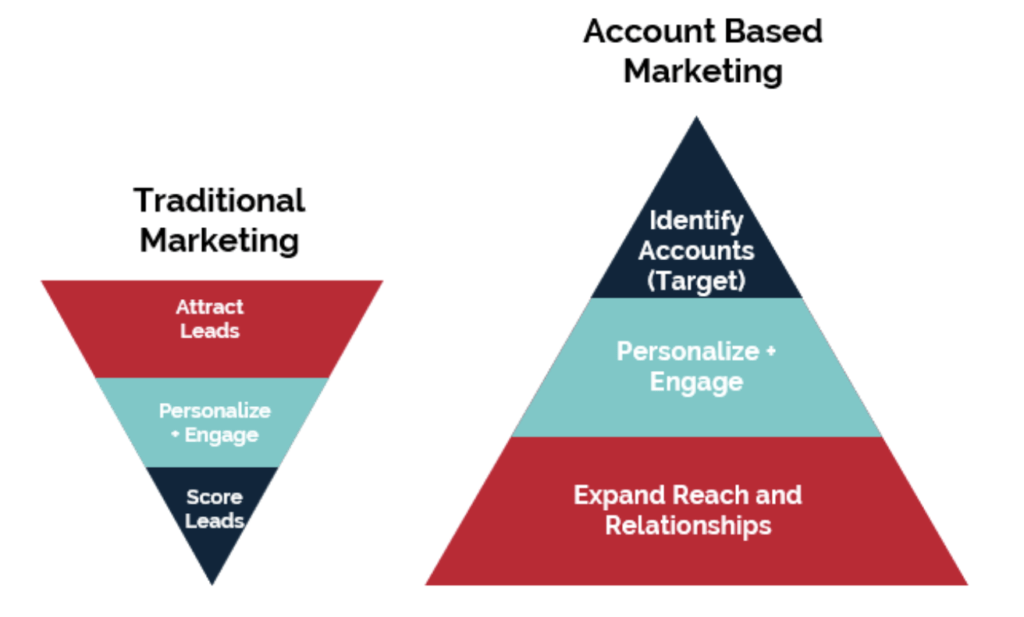Our world is a loud place — we’re constantly bombarded with advertisements competing for space in our busy day. But if you really want to capture someone’s attention, you don’t want to just shout louder. You want to speak directly to them. To reach your target audience, you have to — well — target them. With Account-Based Marketing (ABM), you align your sales and marketing efforts to deliver targeted advertising and content to a focused list of high-value accounts. Instead of marketing to a wide target audience, ABM prioritizes those specific business targets to drive high sales volume and a strong ROI. Simply put, ABM flips the traditional marketing funnel upside down.

According to Hubspot, 70 percent of marketers report using ABM in 2023. If that has you wondering why so many B2B brands moving away from the tried-and-true marketing tactics, you’re in luck. I’m here to tell you the four big reasons marketers are introducing ABM strategies in their marketing mix.
Before I dive in, let me say I only scratch the surface of the capabilities and benefits of an ABM program. There’s a lot that goes into developing an ABM strategy and getting a program up and running. But first, let’s start with the reasons your brand should explore an ABM strategy:
1. Increased Efficiency.
Instead of dedicating time and resources to a large audience that may not purchase your products or services, ABM allows marketers to focus their efforts on select lists of high-value businesses and targets that fit the brand’s ideal customer profile. This enables marketers to create more attractive content and programs that speak directly to the audiences most likely to become customers.
2. The Right Message at the Right Time.
One of the biggest challenges brands face today is figuring out how to deliver personalized content to audiences at each stage of the buying cycle. Individuals are more likely to respond to messages that speak to their specific needs and stage in the buying journey.
ABM allows marketers to target users based on their specific needs, buying intent or historical online behavior, delivering relevant messages to audiences in real-time. Using these audience insights increases engagement, which can boost sales. In today’s world where advertising is ever-present, personalization is critical to help brands break through the noise and capture the attention of their target audience.
3. Closer Alignment Between Sales and Marketing.
It is not uncommon for many sales and marketing teams to operate in silos – the marketing teams focus on generating new leads, while sales teams are focused on nurturing and converting leads. But when marketing and sales teams work toward a common goal and share ownership of business outcomes, it delivers a more consistent brand experience.
One of the biggest advantages of an ABM platform is the ability to ingest first-party sales data, CRM data and account lists to inform ABM targeting strategies. Leveraging shared information allows the marketing teams to hone in on specific high-value accounts the sales team has identified. As a result, the marketing team can deliver more qualified leads to the sales team.
4. Actionable Audience Insights.
ABM platforms can help marketers manage and measure the performance of account lists to understand audience intent signals and develop actionable insights. Audience-intent data, such as keyword searches or content consumption behavior, can be used to identify what stage of the buying cycle a prospect is in. This helps marketers prioritize accounts which are actively researching your product or similar offerings — you know, the ones that will probably make a purchase. This is just one example of the many ways marketers can leverage intent data to inform marketing strategies!
ABM opens the door for marketers to reach new audiences, drive quality leads and garner insights about their audience to inform targeting strategies and develop personalized messaging. It’s no surprise that ABM has become a key tactic in driving sales for B2B brands. Building the foundation for a strong ABM practice takes time and resources – and our Integrated Marketing team is ready to help your brand implement an ABM program. Reach out to see how we can work together!
